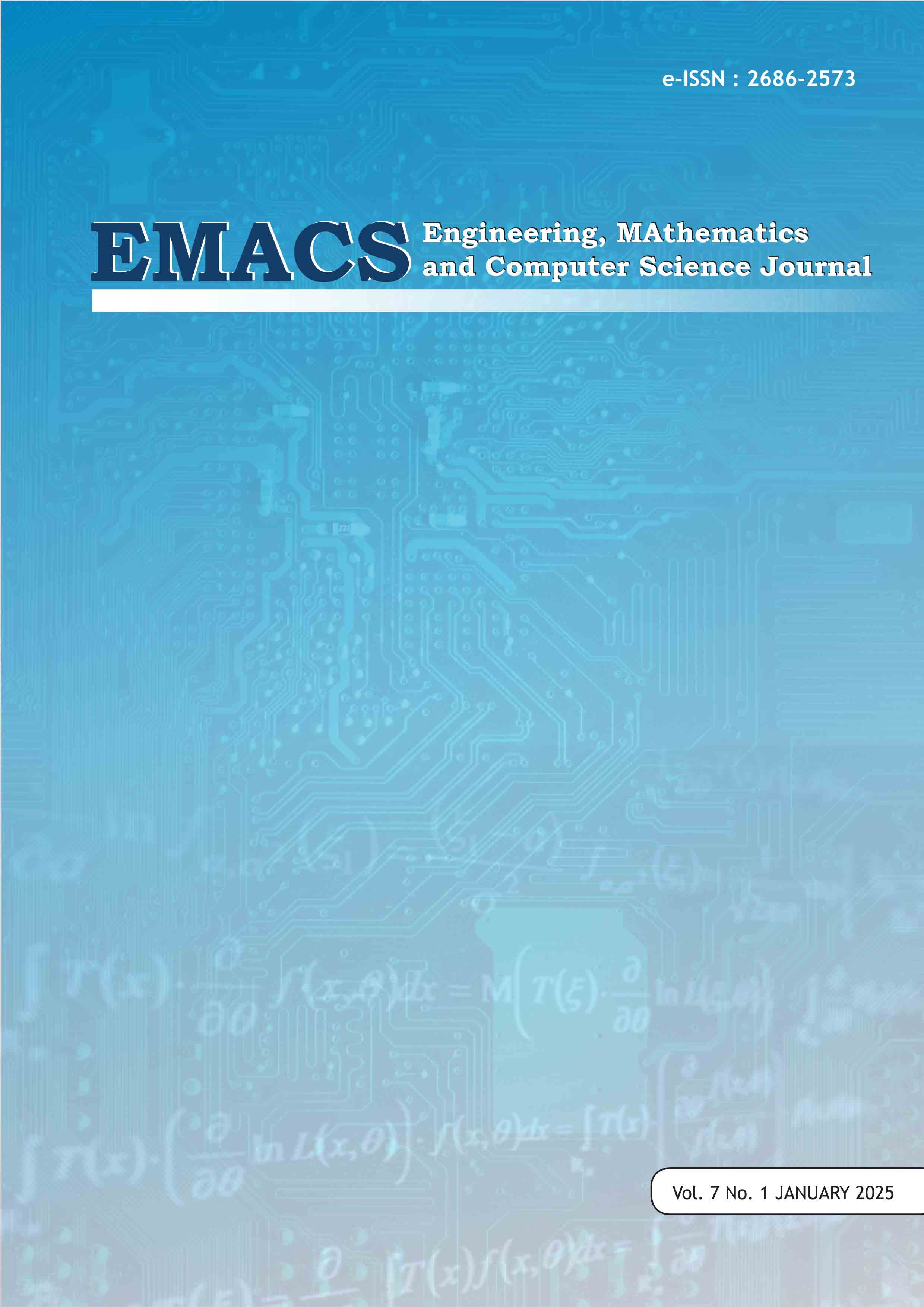Leveraging Support Vector Machines and Ensemble Learning for Early Diabetes Risk Assessment: A Comparative Study
DOI:
https://doi.org/10.21512/emacsjournal.v7i1.12846Keywords:
Diabetes, Prediction, Support Vector Machine, Kernels, Ensemble LearningAbstract
Currently, diabetes is a hidden, serious threat to human lifestyles through daily food and drink, which has become a formidable global health challenge. As a contribution, this study suggests a way to use machine learning to find people with diabetes by looking at certain health parameters. It does this by using different Support Vector Machine (SVM)-based models, such as different SVMs with different kernels, such as linear, polynomial, radial basis function, and sigmoid kernels; different ensemble bagging with SVM; and different ensemble stacking with various SVM models. The findings demonstrated that utilizing a single SVM model with a linear kernel, ensemble bagging with a linear SVM, and ensemble stacking with different SVM models yielded the most accurate results, achieving 95% accuracy in both diabetes presence and absence. This lends credence to the idea that the incorporation of a linear kernel has the potential to improve the accuracy of determining whether or not diabetic illness is present.
References
Aryawibowo, P., Hidayanto, A. F., Toemali, Y. M., Anderies, Setiawan, K. E., & Gunawan, A. A. S. (2023). Intelligent Monitoring and Diagnosing Capability in Healthcare: Systematic Literature Review. 2023 International Conference on Information Management and Technology (ICIMTech), 627–632. https://doi.org/10.1109/ICIMTech59029.2023.10277846
Cortes, C., & Vapnik, V. (1995). Support-vector networks. Machine Learning, 20(3), 273–297. https://doi.org/10.1007/BF00994018
González, S., GarcÃa, S., Del Ser, J., Rokach, L., & Herrera, F. (2020). A practical tutorial on bagging and boosting based ensembles for machine learning: Algorithms, software tools, performance study, practical perspectives and opportunities. Information Fusion, 64, 205–237. https://doi.org/10.1016/j.inffus.2020.07.007
Intelligence and Neuroscience, C. (2023). Retracted: Analysis of Diabetes Clinical Data Based on Recurrent Neural Networks. Computational Intelligence and Neuroscience, 2023(1). https://doi.org/10.1155/2023/9761378
Kaur, H., & Kumari, V. (2022). Predictive modelling and analytics for diabetes using a machine learning approach. Applied Computing and Informatics, 18(1/2), 90–100. https://doi.org/10.1016/j.aci.2018.12.004
Kwon, H., Park, J., & Lee, Y. (2019). Stacking ensemble technique for classifying breast cancer. Healthcare Informatics Research, 25(4), 283–288. https://doi.org/10.4258/hir.2019.25.4.283
Ngo, G., Beard, R., & Chandra, R. (2022). Evolutionary bagging for ensemble learning. Neurocomputing, 510, 1–14. https://doi.org/10.1016/j.neucom.2022.08.055
Prasetyo, S. Y., Setiawan, K. E., & Shiddiqi, H. A. (2024). Assessing the Efficacy of Artificial Neural Networks for Diabetes Risk Prediction. 2024 2nd International Symposium on Information Technology and Digital Innovation (ISITDI), 108–112. https://doi.org/10.1109/ISITDI62380.2024.10796239
Setiawan, K. E., Kurniawan, A., Chowanda, A., & Suhartono, D. (2023). Clustering models for hospitals in Jakarta using fuzzy c-means and k-means. Procedia Computer Science, 216, 356–363. https://doi.org/10.1016/j.procs.2022.12.146
Sinclair, A., Saeedi, P., Kaundal, A., Karuranga, S., Malanda, B., & Williams, R. (2020). Diabetes and global ageing among 65–99-year-old adults: Findings from the International Diabetes Federation Diabetes Atlas, 9th edition. Diabetes Research and Clinical Practice, 162, 108078. https://doi.org/10.1016/j.diabres.2020.108078
Zhang, C., & Ma, Y. (2012). Ensemble Machine Learning. In Ensemble Machine Learning. Springer US. https://doi.org/10.1007/978-1-4419-9326-7
Downloads
Published
How to Cite
Issue
Section
License
Copyright (c) 2025 Hafizh Ash Shiddiqi, Karli Eka Setiawan, Renaldy Fredyan

This work is licensed under a Creative Commons Attribution-ShareAlike 4.0 International License.
Authors who publish with this journal agree to the following terms:
- Authors retain copyright and grant the journal right of first publication with the work simultaneously licensed under a Creative Commons Attribution License - Share Alike that allows others to share the work with an acknowledgment of the work's authorship and initial publication in this journal.
- Authors are able to enter into separate, additional contractual arrangements for the non-exclusive distribution of the journal's published version of the work (e.g., post it to an institutional repository or publish it in a book), with an acknowledgment of its initial publication in this journal.
- Authors are permitted and encouraged to post their work online (e.g., in institutional repositories or on their website) prior to and during the submission process, as it can lead to productive exchanges, as well as earlier and greater citation of published work.
USER RIGHTS
All articles published Open Access will be immediately and permanently free for everyone to read and download. We are continuously working with our author communities to select the best choice of license options, currently being defined for this journal as follows: Creative Commons Attribution-Share Alike (CC BY-SA)





